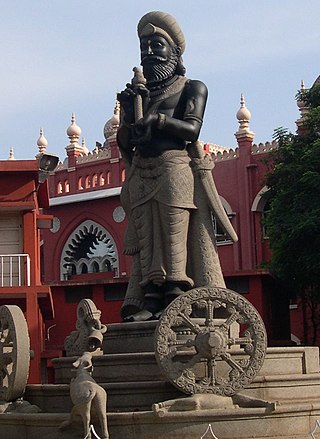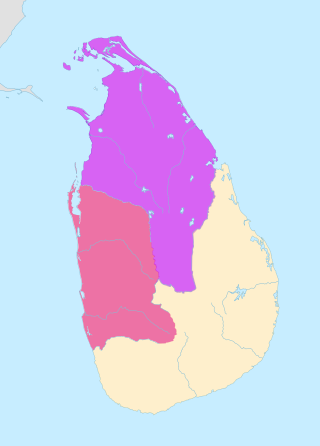
Dutugamunu the Great, also known as Duṭṭhagāmaṇī Abhaya, was a king of the Anuradhapura Kingdom who reigned from 161 BC to 137 BC. He is renowned for first uniting the whole island of Sri Lanka by defeating and overthrowing Elara, the usurping Tamil prince from the Chola Kingdom, who had invaded the Anuradhapura kingdom in 205 BC. Dutugamunu also expanded and beautified the city of Anuradhapura and projected the power of the Rajarata kingdom across the island of Sri Lanka.

Ellalan was a member of the Tamil Chola dynasty in Southern India, also known as "Manu Needhi Cholan", who upon capturing the throne became king of the Anuradhapura Kingdom, in present-day Sri Lanka, from 205 BCE to 161 BCE.

Lilavati was the fourth woman in Sri Lankan history to rule as sovereign in her own right. Lilavati rose to prominence as the wife of Parakramabahu I, king of the Kingdom of Polonnaruwa. Being of royal descent herself, she then ruled as sole monarch on three occasions in the near-anarchy following Parakramabahu's death, with the backing of various generals. The primary source for her life is the Culavamsa, specifically chapter LXXX.
Kalinga Magha or Gangaraja Kalinga Vijayabahu was an invader from the Kingdom of Kalinga who usurped the throne from Parakrama Pandyan II of Polonnaruwa in 1215. A massive migration followed of Sinhalese people to the south and west of Sri Lanka, and into the mountainous interior, as they attempted to escape his power. Magha was the last ruler to have his seat in the traditional northern seat of native power on the island, known as Rajarata; so comprehensive was his destruction of Sinhalese power in the north that all of the successor kingdoms to Rajarata existed primarily in the south of the island.

Parākramabāhu I, or Parakramabahu the Great, was the king of Polonnaruwa from 1153 to 1186. He oversaw the expansion and beautification of his capital, constructed extensive irrigation systems, reorganised the country's army, reformed Buddhist practices, encouraged the arts and undertook military campaigns in South India and Burma. The adage, "Not even a drop of water that comes from the rain must flow into the ocean without being made useful to man" is one of his most famous utterances."

The Kingdom of Polonnaruwa was the Sinhalese kingdom that expanded across the island of Sri Lanka and several overseas territories, from 1070 until 1232. The kingdom started expanding its overseas authority during the reign of Parakramabahu the Great.
Vikramabahu was a medieval king of Sri Lanka. Following the death of his father in 1029, Vikramabahu led the resistance movement against the Chola invaders of the country, ruling from the southern principality of Ruhuna. He spent a number of years building up his forces to drive out the Chola, but died before he could launch his military campaign.
Kitti Sri Megha, also referred to as Kittisrimegha, was a medieval king of the principality of Dakkinadesa in Sri Lanka. The nephew of King Vijayabahu I, he attempted to seize the throne of Sri Lanka along with his two brothers in 1110 CE, but was defeated by Vickramabahu I. He then retreated to the south of the country, which he initially ruled with his younger brother Sri Vallabha. He later ascended to the throne of Dakkinadesa following the death of his older brother Manabharana.

Vijayabahu I, also known as Vijayabahu the Great, was a medieval king of Sri Lanka. Born to a royal bloodline, Vijayabahu grew up under Chola occupation. He assumed rulership of the Ruhuna principality in the southern parts of the country in 1055. Following a seventeen-year-long campaign, he successfully drove the Cholas out of the island in 1070, reuniting the country for the first time in over a century. During his reign, he re-established Buddhism in Sri Lanka and repaired much of the damage caused to infrastructure during the wars. He offered the Thihoshin Pagoda(Lord of Sri Lanka Buddha image) to Burma king Alaungsithu and it is now still in Pakokku.
Dhatusena was a king of Sri Lanka who reigned from 455 to 473 AD. He was the first king of the Moriyan dynasty. In some records, he is also identified as Dasenkeli. Dhatusena reunited the country under his rule after twenty six years of anarchy, defeating the six Dravidians that were ruling the country at that time. Dhatusena built large reservoirs and canals to augment the agriculture in the country.

Anuradhapura Kingdom, named for its capital city, was the first established kingdom in ancient Sri Lanka related to the Sinhalese people. According to the Mahāvaṃsa, it was founded by King Pandukabhaya in 437 BC, whose authority extended throughout the country.

The Anuradhapura period was a period in the history of Sri Lanka of the Anuradhapura Kingdom from 377 BCE to 1017 CE. The period begins when Pandukabhaya, King of Upatissa Nuwara moved the administration to Anuradhapura, becoming the kingdom's first monarch. Anuradhapura is heralded as an ancient cosmopolitan citadel with diverse populations.

The Chola conquest and occupation of Anuradhapura Kingdom was a military invasion of the Kingdom of Anuradhapura by the Chola Empire. It can be seen as an ensuing conflict between Chola and Sinhalese kings after the initial conflict between Chola and the Pandya-Sinhalese alliance during conquest of the Pandya Kingdom by Chola king Paranthka I. After the defeat, Pandya king Rajasimha took his crown and the other regalia and sought refuge in Anuradhapura. The Paranthka made several futile attempts to regain regalia, including invasion of Sri Lanka on a date between 947 and 949 CE during the reign of Sinhalese king Udaya IV. Therefore, one of the driving motives behind the invasions of Anuradhapura by the Cholas' was their desire to possess these royal treasures. The conquest started with the invasion of the Anuradhapura Kingdom in 993 CE by Rajaraja I when he sent a large Chola army to conquer the kingdom and absorb it into the Chola Empire. Most of the island was subsequently conquered by 1017 CE and incorporated as a province of the vast Chola empire during the reign of his son Rajendra Chola I. The Chola occupation would be overthrown in 1070 CE through a campaign of Sinhalese Resistance led by Prince Kitti, a Sinhalese royal. The Cholas fought many subsequent wars and attempted to reconquer the Sinhalese kingdom as the Sinhalese were allies of their arch-enemies, the Pandyas. The period of Chola entrenchment in northern Sri Lanka lasted in total about three-quarters of a century, from roughly 993 CE to 1070 CE, when Vijayabahu I recaptured the north and expelled the Chola forces restoring Sinhalese sovereignty.

The Pandyan Civil War from 1166 to 1182 was precipitated by rival claims of succession to the Pandyan throne. The Civil War began between Parakrama Pandyan and his nephew Kulasekhara Pandyan and lasted for next 15 years between successive Pandyan kings. The war gradually spread to the rest of Southern India when the Chola King Rajadhiraja II and the Sinhalese King Parakramabahu I of Polonnaruwa entered the fray and took opposing sides in the conflict, eager to increase their influence in the Pandya kingdom.

Rajarata [rā dja ra tə] was one of three historical regions of the island of Sri Lanka for about 1,700 years from the 6th century BCE to the early 13th century CE. Several ancient cities, including Tambapanni, Upatissa Nuwara, Anuradhapura and Polonnaruwa, were established as capitals within the area by successive rulers. Rajarata was under the direct administration of the King. Two other areas, Malayarata and Ruhunurata, were ruled by the king's brothers "Mapa" and "Epa". The Magha invasion in the 13th century brought about the end of the Rajarata kingdom.
Ilanaga, also known as Elunna, was King of Anuradhapura in the 1st century, whose reign lasted from 38 to 44. He overthrew and succeeded his aunt Sivali as King of Anuradhapura and was succeeded by his son Chandamukha.

The Polonnaruwa period was a period in the history of Sri Lanka from 1017, after the Chola conquest of Anuradhapura and when the center of administration was moved to Polonnaruwa, to the end of the Kingdom of Polonnaruwa in 1232.
Queen Sugala of Ruhuna also referred to as Sugala Devi, was the last monarch of the Kingdom of Ruhuna, a state which was located in the Southern and Eastern regions of Sri Lanka.
1157 Ruhuna Rebellion, also known as the Rebellion of Queen Sugala, was a revolt led-by Queen Sugala of Ruhuna against the Kingdom of Polonnaruwa ruled by Parakramabahu the Great. The rebellion was suppressed by the army of Parakramabahu, and the kingdom of Ruhuna was annexed as a part of Polonnaruwa in 1158.











